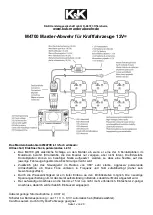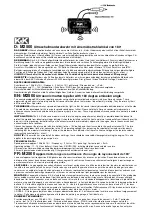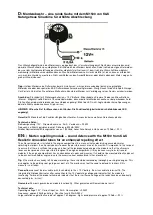
4.3.3 Start-Stop Override and
Configurable Charging
There are two control methods to switch the
power supply system to Conventional Charging.
This may be required for converters requiring
battery voltage that is being charged by the
alternator in the range of 13.5 to 14.9 volts. Such
applications include boost or supplemental battery
charging, compensation for volt drop or high
Ampere electrical loads whilst the engine is
running. Both these methods also inhibit
Start-Stop.
1. Start-Stop Switch - Manual Operation
The Start-Stop deactivation button also
deactivates SRC when pressed (LED telltale is
illuminated). When deactivated, and the vehicle
is stationary, the engine will not shutdown and the
battery will be charged by the alternator with
Conventional Charging.
Summary of the Available Charging Modes
Approximate Charging Voltages
(Measured at Jump Start post)
Charge Mode
Minimum 12.2 - Maximum 14.9
Smart Regenerative Charging - normal charge
mode.
SRC
Minimum 13.5 - Maximum 14.9
Conventional Charging - applies a strong charging
voltage until the battery is full and maintains
alternator voltage above 13.5V unless battery
temperature >40degC. The actual voltage at the
battery will vary depending on the alternator load.
CC
Not Applicable
Start-Stop - there is a 5 second delay from when
the CC/SS inhibitor is activated to when SS is
inhibited.
SS
The voltages in the above table are approximate as the charging system is dynamic and can vary the
voltage at any time.
For further information on Start-Stop
Refer to: 4.8 Electronic Engine Controls (page 148).
2. Hardwire Input
The Hardwire Input can be accessed in three ways:
•
Pre-installed as part of a Camper Donor vehicle
and Ford Skeletal Chassis.
•
Pre-installed as part of the High Specification
Vehicle Interface Connector (A608) and a link
from the Hardwire Input to the chosen switch
and ground point, but must not be a permanent
ground. The grounding should only occur for a
duration of the third party system needing a
certain functionality and performance which
can only be met by turning off the fuel save
features of Smart Charging and Start-Stop.
Grounding permanently might invalidate the
emission and homologation of the vehicle and
the vehicle could need to be re-homologated
as part of the approval process by the converter.
A mating 43 way connector with three meters
of wiring (with all wires) is available as a kit
(KTBK2V-14A411-D_) from your local Ford
dealer. For information on High Specification
Vehicle Interface Connector
Refer to: 4.19 Electrical Connectors and
•
As a kit to install to the standard 8 way Vehicle
Interface Connector in the drivers seat pedestal,
see 'Electrical Connectors and Connection'
section.
Test Functionality: Start-Stop Inhibit - for
vehicles with Start-Stop
1. Check Start-Stop functions as intended, refer
to Owner's Manual for details.
2. While driving the vehicle, close the Hardware
Input Switch, if safe to do so, and check that
the Start-Stop no longer operates.
3. Open the Hardware Input switch and check
Start-Stop functionality is restored.
Test Functionality: SRC Inhibit, Charging
Mode Control
1. Ensure batteries have good charge. When
charging, use the jump start point and engine
bay ground point. Refer to the charging
instructions in the Owner's Manual.
2. Measure voltage between jump start point and
engine bay ground point with engine running
and SRC inhibit switch open. Refer to the
Roadside Emergencies section of the Owner's
Manual.
3. With the engine running, close Hardwire Input
Switch and measure voltage. The voltage
should be in the ranges shown in the table
'Summary of the Available Charging Modes'.
FORD
TRANSIT
2016.75
Date of Publication: 03/2018
EU
4 El
ec
tric
al
106
















































